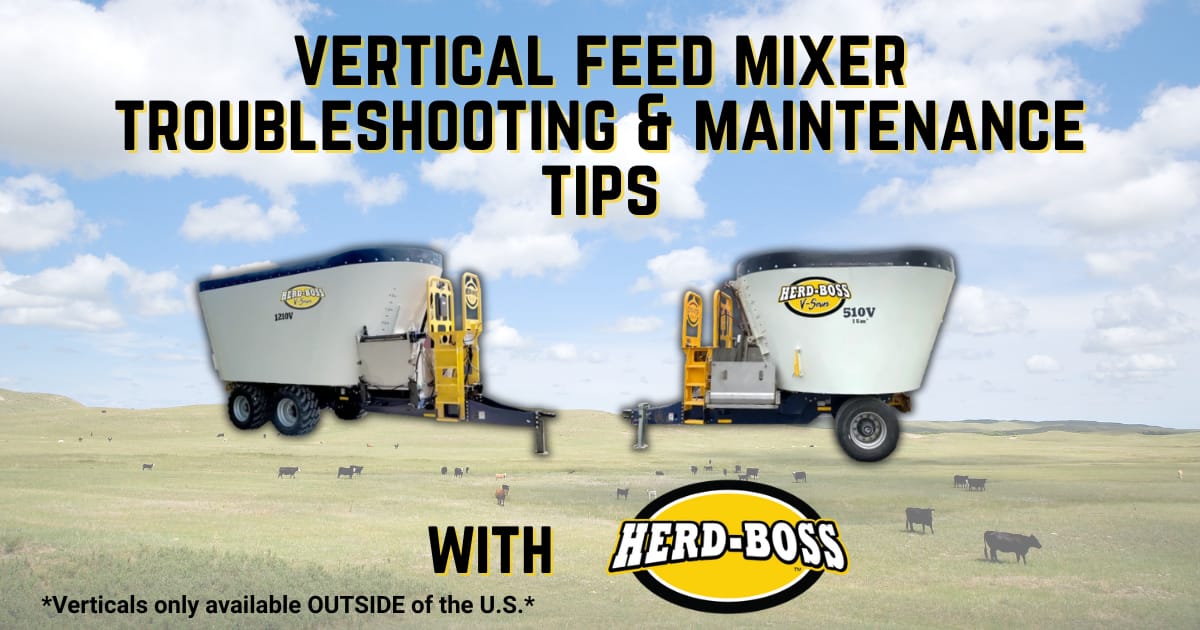Vertical Feed Mixer Troubleshooting & Maintenance Tips

Whether your operation is running a new or used vertical feed mixer, it is essential to be aware of common troubleshooting and maintenance tips. The Herd-Boss team has decades of experience in vertical feed mixer sales and maintenance. Since this is not their first rodeo with vertical mixer breakdowns or feed quality problems, they are sharing their expertise to help you troubleshoot these issues.
Troubleshooting
It’s important to note you shouldn’t ignore the little things—here’s what they’re telling you: Uneven feed mix at the end of a load can often signify a worn mixing blade. Blades will show visible wear, along with auger flighting and knives; these parts are affordable to buy and easy to replace. If you’re overloading or loading incorrectly, you will likely see wear and tear on your knives or kicker plates as well. The final interior warning sign you may see is the thinning of the side wall. If you tap on the side wall and hear thin spots, this indicates that it may be time to install a new liner, typically 36 inches or 50 inches. We recommend starting with the 50-inch right away if possible.
As you can tell, there are some causes and effects when it comes to vertical mixers. It’s important to get to the root of the issues with the following common culprits:
- Poor mixing → Likely a worn mixing blade
- Liner damage → Check regularly with a tap test and watch for wall thinning
Mixer Maintenance
When it comes to maintenance, the frequency at which you take your mixer in may depend on the size of your operation. Big feeders of 5,000+ head should come in every 6 months; for anything smaller, we recommend once a year for inspection. Even though a repair shop can handle fixes well, it’s important to regularly inspect your vertical mixer so you can catch issues early. We recommend you do the following things once a week:
- Look inside your mixer while it’s empty
- Check the condition of knives, kicker plates, and leading edges
- Tap walls to detect thin spots
- Check oil reservoirs
- Ensure planetary gearboxes are properly greased
- Monitor for any strange noises or uneven mixing
Oftentimes, maintenance items get overlooked when things get busy, but small steps people skip lead to big problems later. To avoid downtime, you may consider having a couple of spare parts on hand, such as discharge connector links, discharge bearings, knives, chain links for the discharge, and possibly kicker plates or mixing blades (based on wear patterns). When ordering parts, ensure you take note of your mixer’s model and serial number. This will make sure you get the exact match you need.
You can help extend the life of your mixer. Let’s go over good habits that protect your investment:
- Stay on a regular maintenance schedule
- Grease and oil consistently
- Replace high-wear parts before they fail
We’re Here for You
At the end of the day, your operation is unique, but the problems you are troubleshooting are common. At Herd-Boss, we pride ourselves on having the knowledge and resources to help you continue to successfully feed your herd with your vertical mixer. We encourage you to see the long-term benefits of keeping up with your maintenance, taking the time to look over your mixer weekly, and paying attention to the needs of your operation.
Many Thanks to Herd-Boss Feeders
for sharing their knowledge and tips to our readers.
Their contact information is listed below.
Email:
sales@herdbossfeeders.comPhone: 712-476-BOSS (2677)